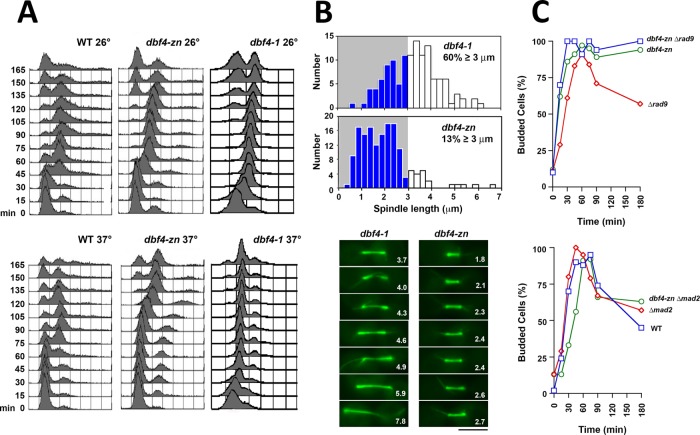FIGURE 3:
dbf4-zn does not undergo a reductional anaphase. Experiments in this figure are without HU treatment. (A) FACs. WT (CRY1), dbf4-1 (JBY999), or dbf4-zn expressed from the native locus (JJY076) strains were arrested in G1, released at 26°C or 37°C, and analyzed by FACs. dbf4-zn shows an ∼15 min S phase delay compared with WT at 26°C and an ∼45–60 min delay at 37°C. (B) Top graphs: a dbf4-1 SPC42-GFP strain (JBY1392) and a strain expressing SPC42-GFP and integrated dbf4-zn (JJY045) were released from G1 at 37°C. After 2 h, spindle length distributions were determined using Spc42-GFP. Bottom micrographs: dbf4-1 (JBY2323) and integrated dbf4-zn (JBY2324) cells expressing GFP-TUB1 were released from G1 at 37°C. After 2 h spindles were visualized at 37°C. Numbers, spindle length in μm; bar, 4 μm. Whereas dbf4-1 exhibits reductional anaphase spindle extension, dbf4-zn arrests with normal length preanaphase spindles. (C) The dbf4-zn cell cycle arrest. Top graph: rad9-∆ (JBY186), integrated dbf4-zn (JJY076) and integrated dbf4-zn rad9-∆ (JJY080) double mutants were released from G1 at 37°C, and budding was used to evaluate cell cycle progression. Bottom graph: WT (CRY1), mad2-∆ (JBY546), and integrated dbf4-zn mad2-∆ (JJY102) strains were analyzed similarly. As with dbf4-1, dbf4-zn cell cycle arrest is dependent on Mad2 but not Rad9.

